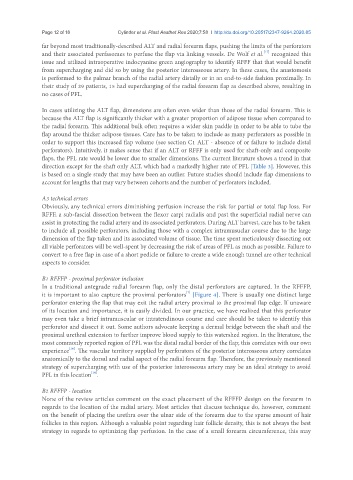Page 678 - Read Online
P. 678
Page 12 of 18 Cylinder et al. Plast Aesthet Res 2020;7:58 I http://dx.doi.org/10.20517/2347-9264.2020.85
far beyond most traditionally-described ALT and radial forearm flaps, pushing the limits of the perforators
[17]
and their associated perfasomes to perfuse the flap via linking vessels. De Wolf et al. recognized this
issue and utilized intraoperative indocyanine green angiography to identify RFFF that that would benefit
from supercharging and did so by using the posterior interosseous artery. In these cases, the anastomosis
is performed to the palmar branch of the radial artery distally or in an end-to-side fashion proximally. In
their study of 29 patients, 15 had supercharging of the radial forearm flap as described above, resulting in
no cases of PFL.
In cases utilizing the ALT flap, dimensions are often even wider than those of the radial forearm. This is
because the ALT flap is significantly thicker with a greater proportion of adipose tissue when compared to
the radial forearm. This additional bulk often requires a wider skin paddle in order to be able to tube the
flap around the thicker adipose tissues. Care has to be taken to include as many perforators as possible in
order to support this increased flap volume (see section C1 ALT - absence of or failure to include distal
perforators). Intuitively, it makes sense that if an ALT or RFFF is only used for shaft-only and composite
flaps, the PFL rate would be lower due to smaller dimensions. The current literature shows a trend in that
direction except for the shaft only ALT, which had a markedly higher rate of PFL [Table 3]. However, this
is based on a single study that may have been an outlier. Future studies should include flap dimensions to
account for lengths that may vary between cohorts and the number of perforators included.
A3 technical errors
Obviously, any technical errors diminishing perfusion increase the risk for partial or total flap loss. For
RFFF, a sub-fascial dissection between the flexor carpi radialis and past the superficial radial nerve can
assist in protecting the radial artery and its associated perforators. During ALT harvest, care has to be taken
to include all possible perforators, including those with a complex intramusuclar course due to the large
dimension of the flap taken and its associated volume of tissue. The time spent meticulously dissecting out
all viable perforators will be well-spent by decreasing the risk of areas of PFL as much as possible. Failure to
convert to a free flap in case of a short pedicle or failure to create a wide enough tunnel are other technical
aspects to consider.
B1 RFFFP - proximal perforator inclusion
In a traditional antegrade radial forearm flap, only the distal perforators are captured. In the RFFFP,
[7]
it is important to also capture the proximal perforators [Figure 4]. There is usually one distinct large
perforator entering the flap that may exit the radial artery proximal to the proximal flap edge. If unaware
of its location and importance, it is easily divided. In our practice, we have realized that this perforator
may even take a brief intramuscular or intratendinous course and care should be taken to identify this
perforator and dissect it out. Some authors advocate keeping a dermal bridge between the shaft and the
proximal urethral extension to further improve blood supply to this watershed region. In the literature, the
most commonly reported region of PFL was the distal radial border of the flap; this correlates with our own
[16]
experience . The vascular territory supplied by perforators of the posterior interosseous artery correlates
anatomically to the dorsal and radial aspect of the radial forearm flap. Therefore, the previously mentioned
strategy of supercharging with use of the posterior interosseous artery may be an ideal strategy to avoid
PFL in this location .
[16]
B2 RFFFP - location
None of the review articles comment on the exact placement of the RFFFP design on the forearm in
regards to the location of the radial artery. Most articles that discuss technique do, however, comment
on the benefit of placing the urethra over the ulnar side of the forearm due to the sparse amount of hair
follicles in this region. Although a valuable point regarding hair follicle density, this is not always the best
strategy in regards to optimizing flap perfusion. In the case of a small forearm circumference, this may

